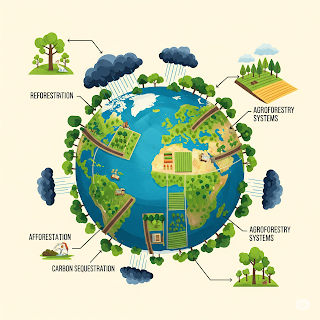As the world grapples with the escalating consequences of climate change—rising temperatures, erratic weather patterns, and biodiversity loss—nature-based solutions are gaining renewed attention. Among the most promising are reforestation, afforestation, and agroforestry. These green strategies serve as vital carbon sinks while delivering co-benefits like water conservation, improved soil health, and socio-economic resilience.
This essay provides a deep, data-backed analysis of how these practices function, their unique roles, challenges in implementation, and why they are indispensable in climate mitigation and adaptation.
Reforestation: Restoring What Was Lost
What Is Reforestation?
Reforestation is the process of replanting trees in areas that were previously forested but have been degraded or deforested. It aims to restore lost ecosystems, sequester carbon dioxide, and rebuild biodiversity.
Technical Insights
Carbon Sequestration: Reforestation projects can sequester up to 10–20 tons of CO₂ per hectare per year.
Soil Stabilization: Tree roots reduce erosion and runoff, stabilizing landscapes.
Hydrological Benefits: Restored forests increase groundwater recharge and reduce flood risks.
Notable Projects
China’s Loess Plateau Project restored 35,000 km² of land, increasing vegetation cover by 17%.
India’s Green India Mission aims to reforest 5 million hectares, enhancing ecosystem services and carbon storage.
Afforestation: Creating New Forest Frontiers
Defining Afforestation
Afforestation involves planting trees in areas that have never been forested in recent history. While it offers similar benefits to reforestation, it comes with its own ecological and geographical considerations.
Key Technical Considerations
Site Suitability: Not all ecosystems (e.g., grasslands) are appropriate for afforestation; planting in the wrong areas can disrupt native biodiversity.
Carbon Absorption: Initial carbon sequestration is slow but accelerates as trees mature.
Albedo Effect: Dark forest canopies can absorb more heat than reflective grasslands—this must be accounted for in climate models.
Global Examples
Ethiopia’s Green Legacy Initiative planted over 4 billion trees in 2020 alone.
Pakistan’s Billion Tree Tsunami focused on afforestation in degraded landscapes, enhancing water tables and biodiversity.
Agroforestry: Farming with Trees for a Sustainable Future
What Is Agroforestry?
Agroforestry integrates trees with crops or livestock on the same land, creating a synergistic system that enhances productivity and sustainability.
Why It Works
Carbon Benefits: Agroforestry systems store up to 63 tons of carbon per hectare.
Soil Health: Tree litter adds organic matter, boosting microbial activity.
Economic Resilience: Diversified yields (fruits, timber, fodder) protect farmers from market and climate shocks.
Types of Agroforestry Systems
Alley Cropping: Trees planted in rows between crops
Silvopasture: Combining forestry and grazing of domesticated animals
Windbreaks: Rows of trees to reduce wind erosion and protect crops
Real-World Case
India’s National Agroforestry Policy (2014) was the first of its kind globally, encouraging farmers to integrate trees for carbon storage and livelihood support.
Comparative Analysis
| Feature | Reforestation | Afforestation | Agroforestry |
|---|---|---|---|
| Land Type | Previously forested | Never forested | Agricultural lands |
| Carbon Sequestration | High (if native forests) | Moderate to high | Moderate, with co-benefits |
| Biodiversity Impact | Positive (native species) | Depends on tree choice | Positive (if diverse) |
| Socioeconomic Value | Medium | Medium | High |
Policy and Funding Mechanisms
International Frameworks
REDD+ (Reducing Emissions from Deforestation and Forest Degradation): Supports forest conservation and carbon credits.
Bonn Challenge: Aims to restore 350 million hectares of forest by 2030.
National Programs
India: CAMPA funds used for compensatory afforestation.
Brazil: Agroforestry integrated into low-carbon agriculture plans.
Financing Challenges
Long-term ROI deters private investment
Land tenure and ownership disputes
Need for consistent monitoring and MRV (Measurement, Reporting, Verification)
Challenges and Criticisms
1. Monoculture Plantations
Replanting single-species forests (e.g., eucalyptus) can reduce biodiversity and water availability.
2. Land Use Conflicts
Tree planting on agricultural land or pastures can cause displacement and food insecurity if not planned inclusively.
3. Carbon Accounting Gaps
Many projects fail to consider full life-cycle emissions, including land prep, seedling transport, and maintenance.
Co-Benefits and Synergies
Climate Resilience: Trees reduce heat stress, buffer storms, and increase drought resistance.
Public Health: Trees filter air pollutants and improve mental well-being.
Ecosystem Services: Pollination, pest control, and nutrient cycling are enhanced.
The Way Forward: Integrating with Climate Action
To meet the Paris Agreement targets, natural climate solutions like these must complement emission cuts from fossil fuels. They are not a silver bullet—but a powerful piece of the puzzle.
Recommendations:
Prioritize native species and biodiversity over commercial monocultures
Ensure community involvement and benefit-sharing
Integrate forest strategies into national climate policies (NDCs)
Leverage carbon markets with strong verification protocols
Conclusion
Reforestation, afforestation, and agroforestry are not just tree-planting schemes—they are strategic tools for climate resilience, ecological recovery, and economic development. Their success hinges on ecological wisdom, scientific planning, and equitable governance.
In an era of rising emissions and shrinking carbon budgets, these green shields offer hope grounded in science and rooted in soil.


No comments:
Post a Comment